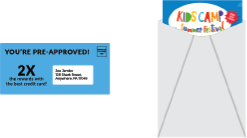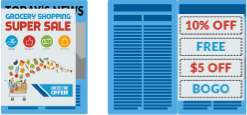What is Direct Mail?
Direct mail campaigns involve printing and mailing items to a set of recipients from a mailing list. They are typically conducted for a variety of marketing purposes. Our goal is to provide you with an overview of direct mail's processes, methods, formats, and costs so you can make informed decisions about your direct mail marketing strategies.
Let's get started!
Direct Mail Processes
Direct mail campaigns involve:
- Audience analysis
- List generation and purchasing
- Copywriting
- Graphic design
- Variable Data Printing & Addressing
- Sorting & Bundling to reduce Postage
- Transport to USPS for delivery by mail
Suppose you're a marketing manager for a small residential plumbing business that seeks to expand its local customer base through a local direct mail campaign. You might first ask yourself who would be most responsive to a mailed advertisement for residential plumbing services - local homeowners, property management companies, and landlords. You then consult with a mailing list vendor to generate and purchase a mailing list that targets local members of this audience.
With your mailing list ready, you decide on a postcard for your campaign's mailer. You create press ready artwork for your mailer that meets USPS requirements for direct mail advertising. You then consult with a printing company to place an order for postcards with direct mail services. The printing company's prepress team inspects the artwork to ensure that it can be printed and mailed while their mailing team processes your mailing list for inkjetting. Once the postcards are printed, the mailing team inkjets the recipient addresses from the mailing list onto each postcard before they are transported to USPS for delivery by mail.
Several key elements must be carefully managed in order for a direct mail campaign to be successful. The quality of the mailing list, artwork, printing, and the timing of the campaign itself are all critical. Oversights can lead to costly mistakes. What's more, direct mail is not for everyone. Knowing who most commonly uses direct mail as well as how they use it will help you decide if direct mail services are right for your marketing plan.

Who Uses Direct Mail?
Any business that sells a product, offers a service, or fulfills a need can potentially benefit from direct mail advertising.
- Restaurants, retailers, and home based services mail menus, coupons, and promotions.
- Politicians, charities, and nonprofit groups send campaign collateral, donation letters, and newsletters.
- Technology based companies use direct mail marketing to reach out to their prospects.
Knowing more about direct mail's methods as well as their pros and cons will help you maximize your direct mail campaign's return on investment (ROI).
Direct Mail Methods
There are two main methods to prepare direct mail: shared mail and solo mail. Shared mail is when advertisers share space with other advertisers on the same mailer. Solo mail is when your advertising has its own mailer.

Shared Mail
Shared mail is when advertisers share space on a mailer. Predefined mailing areas make mailing lists unnecessary. You split the postage with the other advertisers. Shared mail is a cost effective option for many individuals and organizations. Examples of shared mail include Valpak, RedPlum, and Clipper Magazine.
ProPrint does not prepare shared mail.

Pros
- Mailed to every address in a mailing area
- Low cost

Cons
- Your ad is hidden among dozens of other ads
- You're likely to appear alongside your competitors
- No personalization options for your mailer
- No targeting options for your list
- Lower response rates

Solo Mail
Solo mail is when an advertiser has a mailer all to themselves. You define the mailing area as well as your audience. You can mail to an entire region or target a specific set of targeting options. As long as your artwork meets USPS requirements for direct mail advertising, the only limit to how creative you can be is your budget.
ProPrint only prepares solo mail.

Pros
- Mailed to entire area or a targeted audience
- Targeted audiences based on demographics, geography, etc.
- Countless layout and design options for your mailer
- Higher response rates

Cons
- Higher cost than shared mail
Direct Mail Formats
There are six formats of direct mail, also known as mail pieces, products, types, or mailers. A mailer is any piece of direct mail, no matter what shape or size it is. Below are some of the most common mailer formats with some suitable use cases.
Direct Mail Postcards
Postcards are a cost effective option and the most prevalent type of direct mail. You can choose from several sizes.
Best For:
- Save the date cards
- Prospecting promotions


Direct Mail Letter Kits
Envelopes help hide the contents of your letters from prying eyes. Because there is more than one piece, they cost more than postcards or folded selfmailers. There are numerous options for envelope color, size, and material
Best For:
- Confidential mail
- Mail with more than one component (letter, brochure, order forms, reply envelopes, etc.)
- Fundraising and capital campaigns
Folded Self Mailers (FSM's)
Folded Self-mailers (brochures, menus, etc.) do not require an envelope, so they are a low-cost option. They're usually constructed from a single folded sheet of paper or card stock and are often tabbed or glued to keep closed.
Best For:
- Explaining products and services in depth
- Offering lots of coupons
- Newsletters


Catalogs and Booklets
Catalogs and booklets are multi-page mail pieces with a bound edge. They're available in a variety of sizes and are usually mailed as is or in a clear bag.
Best For:
- Showcasing a lot of products and marketing content
- Informational packets
- Newsletters
Circulars, Inserts, and Wraps
Circulars, inserts, and wraps are an efficient and cost-effective marketing format. They're printed on lightweight paper. Inserts and wraps appear inside or around larger pieces like newspapers.
Best For:
- Distributing print coupons
- Product and sales advertisements


Parcels and Dimensional Mailers
Parcels and dimensional mailers aren't flat like postcards or letters. Their design and size help you grab your prospects' attention, but they can be costly
Best For:
- Mailing to a small group of high-value prospects
ProTip:
Pricing out each component of your campaign can be time-consuming and frustrating. ProPrint will work with you to choose the specifics of your campaign, help you acquire a mailing list, print and finish the pieces and mail them. ProPrint will also work with you to keep the total cost within your budget. We even have a tool to assist you in calculating a budget for your campaign.
Estimate your Campaign BudgetDirect Mail Costs
Costs for a direct mail campaign occur in four main areas - list generation/purchasing, design/copywriting, printing, and postage
List generation/purchasing: There are three basic types of mailing lists - saturation lists, targeted consumer lists, and business lists. Saturation lists are generated to mail to all the addresses on a carrier route or an entire zip code. These lists tend to be more cost effective than targeted mailing lists. Targeted mailing lists are generated using targeting selects of consumers and businesses to mail to a specific audience. Targeted mailing lists tend to cost more than saturation lists. ProPrint includes the most common targeting options with our targeted mailing lists.
Design/copywriting: : Design work and copywriting are most commonly done for a fee, but some providers include design services as a courtesy. If you have the skills, you can do your own design work and copywriting to reduce your overall costs. ProPrint does not offer design or copywriting services.
Printing: Printing costs vary based on the quantity and complexity of what you're printing. The smaller and simpler the format, the lower the cost to print your mailers. Adding variable data printing (VDP) and printing on high end materials or finishes will increase your printing costs.
Postage: Postage is the single largest cost of a direct mail campaign. Several factors determine your campaign's final postage rate. Saturation, and Marketing Mail postage rates are lower than First-Class Mail. Your format and mailing list type will determine which of these options are available.
